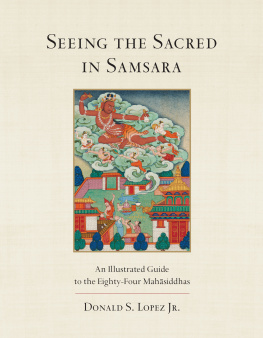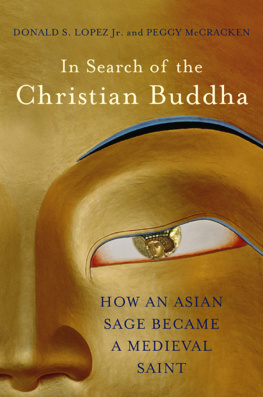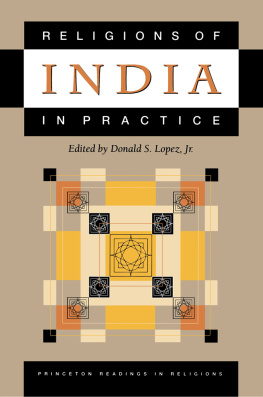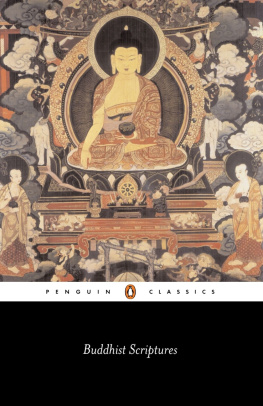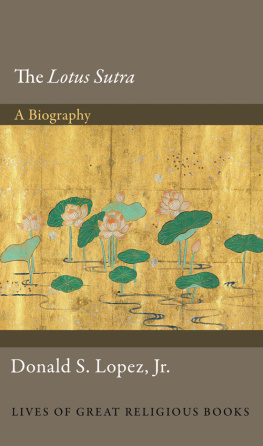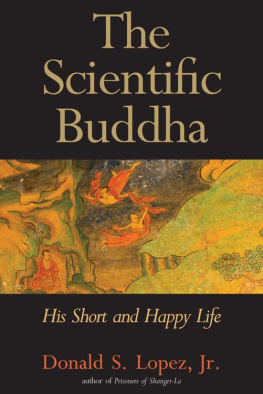Lopez Donald S. - Seeing the Sacred in Samsara
Here you can read online Lopez Donald S. - Seeing the Sacred in Samsara full text of the book (entire story) in english for free. Download pdf and epub, get meaning, cover and reviews about this ebook. year: 2019, publisher: Penguin Random House LLC (Publisher Services), genre: Religion. Description of the work, (preface) as well as reviews are available. Best literature library LitArk.com created for fans of good reading and offers a wide selection of genres:
Romance novel
Science fiction
Adventure
Detective
Science
History
Home and family
Prose
Art
Politics
Computer
Non-fiction
Religion
Business
Children
Humor
Choose a favorite category and find really read worthwhile books. Enjoy immersion in the world of imagination, feel the emotions of the characters or learn something new for yourself, make an fascinating discovery.
- Book:Seeing the Sacred in Samsara
- Author:
- Publisher:Penguin Random House LLC (Publisher Services)
- Genre:
- Year:2019
- Rating:3 / 5
- Favourites:Add to favourites
- Your mark:
- 60
- 1
- 2
- 3
- 4
- 5
Seeing the Sacred in Samsara: summary, description and annotation
We offer to read an annotation, description, summary or preface (depends on what the author of the book "Seeing the Sacred in Samsara" wrote himself). If you haven't found the necessary information about the book — write in the comments, we will try to find it.
Seeing the Sacred in Samsara — read online for free the complete book (whole text) full work
Below is the text of the book, divided by pages. System saving the place of the last page read, allows you to conveniently read the book "Seeing the Sacred in Samsara" online for free, without having to search again every time where you left off. Put a bookmark, and you can go to the page where you finished reading at any time.
Font size:
Interval:
Bookmark:

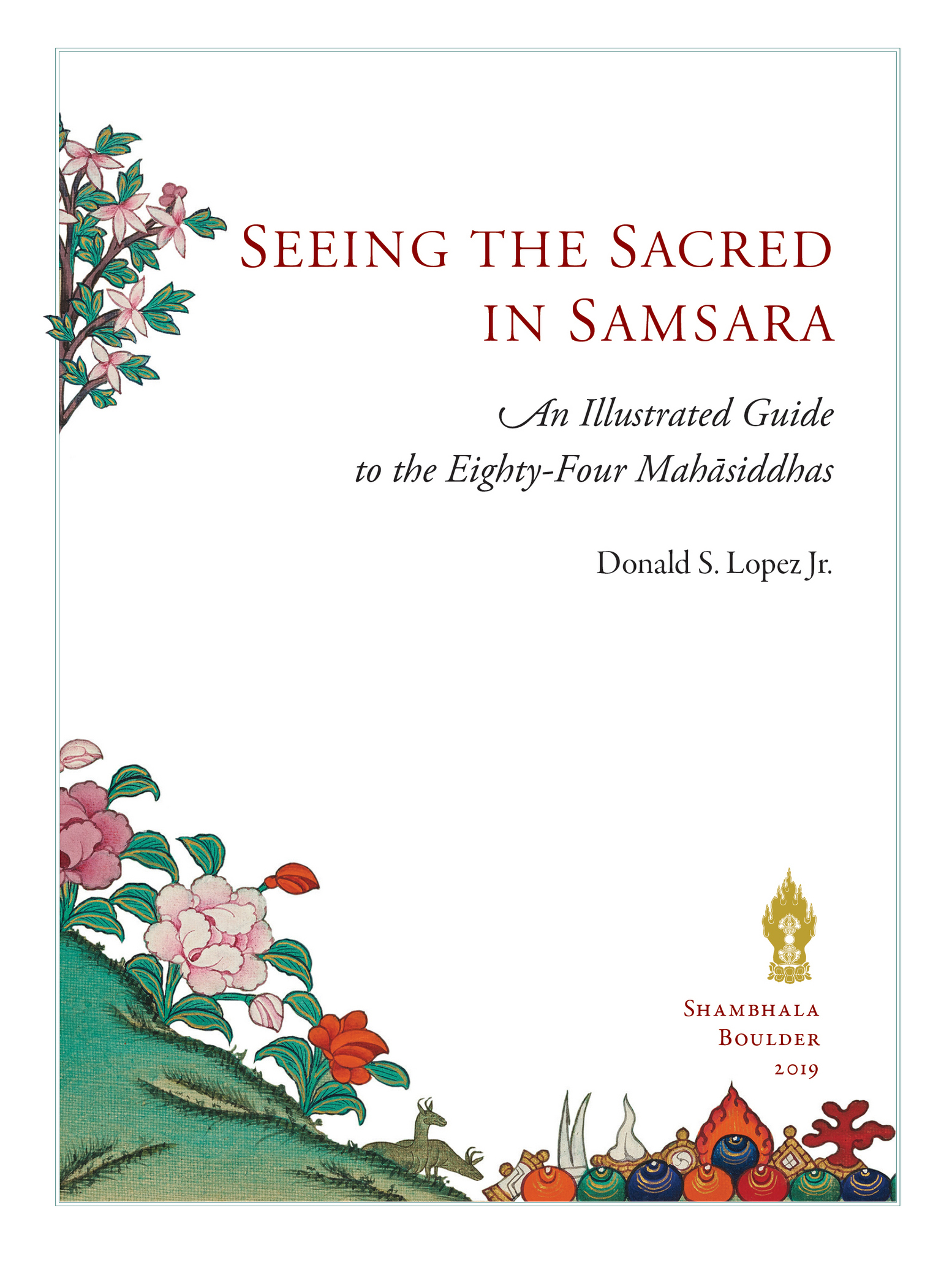
Shambhala Publications, Inc.
4720 Walnut Street
Boulder, Colorado 80301
www.shambhala.com
2019 by Donald S. Lopez Jr. and Tenzin Namgyal Tethong
All rights reserved. No part of this book may be reproduced in any form or by any means, electronic or mechanical, including photocopying, recording, or by any information storage and retrieval system, without permission in writing from the publisher.
Ebook design adapted from printed book design by Gopa & Ted2, Inc.
Cover art: The mahsiddha Drika, reproduced courtesy of Tenzin Namgyel
Library of Congress Cataloging-in-Publication Data
Names: Lopez, Donald S., Jr., 1952 author. | Taranatha, Jo-nang-pa, 1575
Title: Seeing the sacred in samsara: an illustrated guide to the eighty-four mahsiddha / Donald S. Lopez Jr.
Description: First edition. | Boulder: Shambhala, 2019. | Includes bibliographical references.
Identifiers: LCCN 2018022090 | ISBN 9781611804041 (hardcover: alk. paper)
eISBN9780834842120
Subjects: LCSH: Siddhas in art. | Vajradhara (Buddhist deity)Art. | Tantric-Buddhist paintingTibet Region. | Painting, Tibetan20th century.
Classification: LCC N8193.3.S53 L67 2019 | DDC 704.9/48943dc23
LC record available at https://lccn.loc.gov/2018022090
v5.4
a
I T IS WITH a deep sense of accomplishment that I welcome this publication of the portraits and biographies of the eighty Buddhist saints. Although I always refer to them as the eighty saints, they should properly be referred to as the eighty drup-chen (great accomplished ones) in Tibetan, or mahsiddhas in Sanskrit. There are actually eighty-four of them in this collection, along with a principal buddha as the central figure.
These paintings were originally intended for a family chapel, a mani lhakhang, that my grandfather wanted to build in our home in Lhasa. Returning to the capital in 1935 after seventeen years of military service in eastern Tibet, he died before he was able to build the chapel. He died in 1938 at the young age of forty-eight. Years of difficult campaigns driving Chinese forces from Tibet took their toll. Thus, the paintings were never properly framed in silk brocade in the traditional way for hanging.
My late father kept these paintings close to him for sentimental and historical reasons. Because of their small size, together no larger than a hardcover book, he took them to every temporary home we made in our early refugee years in India after 1959. Later, when the collection came into my possession, it traveled from Dharamsala to New York City, to Falls Church, Virginia, Palo Alto, California, and back to northern Virginia. Now, finally, in a published form, the paintings have found a new home.
I am most grateful to Donald Lopez for making this publication possible, and for allowing me to claim a sense of accomplishment, which I would not have been able to do alone. I had for many years harbored the hope to publish these paintings, but knew that without a proper accompanying text, it would be incomplete. While the paintings are a testament to the fine painting tradition and skills of the artists in Derge, the collection is made whole and meaningful by the biographies and the excellent introduction by Professor Lopez. I am especially pleased that the book has been published by Shambhala, which has been such a valuable resource for the people of Tibet and the world.
Professor Lopez and I first met in 1979, during His Holiness the Dalai Lamas first trip to the United States. He was a graduate student at the University of Virginia and served as its liaison with the Office of Tibet, which I headed in my capacity as His Holinesss representative. I first thought of asking him for help on this project when we met on several occasions at Stanford University where he came to lecture occasionally and where I was affiliated with the Tibetan Studies Initiative in the Department of Religious Studies. I attended his lectures, and even joined him on a panel discussion about the Tibetan system of tulkus, recognized reincarnated teachers, together with three Tibetan tulkus living in the United States: Arjia Rinpoche from Indiana, Telo Tulku of Kalmykia, and Thepo Tulku from the San Francisco Bay Area. On another occasion, during a lecture on his translation of the poems of Gendun Chopel, one of Tibets most renowned scholars of the twentieth century, Professor Lopez gave me the honor of reading one of the poems in Tibetan, in remembrance of Gendun Chopels friendship with my late father, Gyurme Gyatsos son.
I think Gyurme Gyatso would be pleased to see his saints shared with the rest of the world. He made a special effort to commission the collection and to have each saint individually recognized by taking them to Lhasa, the center of the Tibetan Buddhist world, for all to see. And now, the saints have gone far beyond Tibet.
Gyurme Gyatso was a warrior, not just for the courage he showed in battle. He chose to take on the task before him and protect those in need, and he believed in the sovereignty of the land and people of Tibet. He survived many campaigns and returned to Lhasa as one who had vanquished the enemy, something Tibetans had not done since the time of the ancient Tibetan kings, more than a thousand years before. He is fondly remembered in a popular nangma (ballad) of the day, Sungtse La.
Several years ago, when visiting an old friend in Thimphu, Bhutan, I called on his ailing mother. The moment I was introduced, she said, Of course, I know Tethong Dapon. Referring to my grandfather as Dochi (governor of eastern Tibet), she went on to say that she was only a child when he was in Kham, but she knew how much he was admired. It was reassuring to hear her speak about him with such respect; some high officials from Lhasa did not perform their duties in distant postings with integrity. I felt a reconnection to my grandfather and to Derge, the ladys hometown, where the saintly portraits in this collection were made. I was reminded of the paintings and of the chapel that my grandfather could not build, behind the home that none of his descendants have been able to visit since 1959.
The lives of the mahsiddhas were assembled to inspire; that no matter ones station in life, or ones abilities, rudimentary or profound, each can become an accomplished one on the path to enlightenment and liberation.
Tenzin Namgyal
Grandson of Tethong Gyurme Gyatso
F ROM R AHUL S ANKRITYAYAN S 1934 essay on the mahsiddhas to the present day, much scholarly attention has been devoted to the great variation in the rendering of their names, variations that derive both from the several Indian vernaculars from which their names likely derive, as well as the different ways in which those names were transliterated into Tibetan. A number of works, including James Robinsons Buddhas Lions, Ulrich von Schroeders Empowered Masters, and Rob Linrothes Holy Madness (all referenced in the introduction to this volume) provide useful charts and appendices on the variants in the names. Because James Robinsons book is the most widely read translation of the lives of the mahsiddhas, the versions of the names provided there have been used in the present volume.
I WOULD FIRST LIKE to thank my old friend Tenzin Namgyal Tethong for asking me to write a book about his grandfathers remarkable set of paintings, one of the few full sets of individual paintings of the famous tantric saints to survive from Tibet. He also kindly provided the information about his family that appears in the introduction. Much of the research for the volume was conducted as part of a graduate seminar in the Winter semester of 2017 at the University of Michigan, where a group of four advanced graduate students in Tibetan Buddhist StudiesRebecca Bloom, Eric Haynie, Anna Johnson, and T. Joseph Leachworked with me in developing many of the materials that appear here, including the translation of Kahthog Rigdzin Tsewang Norbus version of Tranthas painting guide as well as the discussion of the aesthetics of the paintings. Joe Leach deserves particular praise for his efforts to determine the hanging pattern for the paintings. The distinguished scholar of Tibetan Buddhist art, David Jackson, offered helpful comments on the painting guide. The remarkable photographer of Asian art, Neil Greentree, provided high definition photographs of each of the eighty-five paintings. At Shambhala Publications, Nikko Odiseos and Casey Kemp expertly guided the manuscript through the production process.
Font size:
Interval:
Bookmark:
Similar books «Seeing the Sacred in Samsara»
Look at similar books to Seeing the Sacred in Samsara. We have selected literature similar in name and meaning in the hope of providing readers with more options to find new, interesting, not yet read works.
Discussion, reviews of the book Seeing the Sacred in Samsara and just readers' own opinions. Leave your comments, write what you think about the work, its meaning or the main characters. Specify what exactly you liked and what you didn't like, and why you think so.

